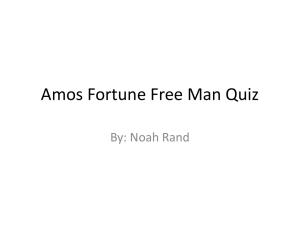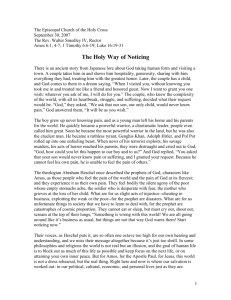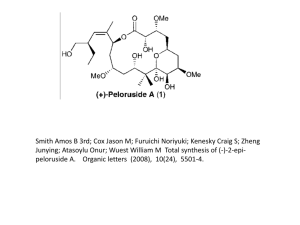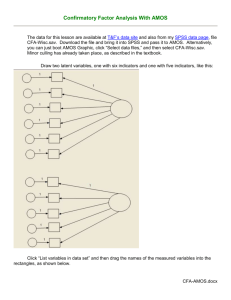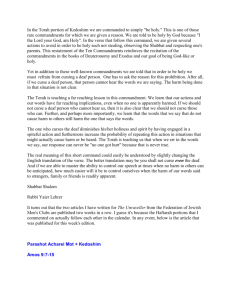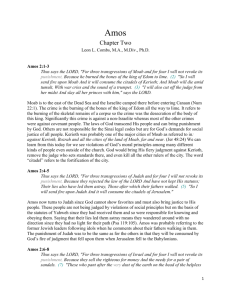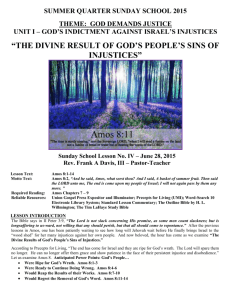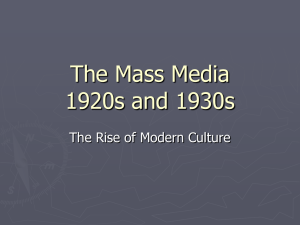Amos Fortune Civil War Unit Plan for Grades 5-8
advertisement
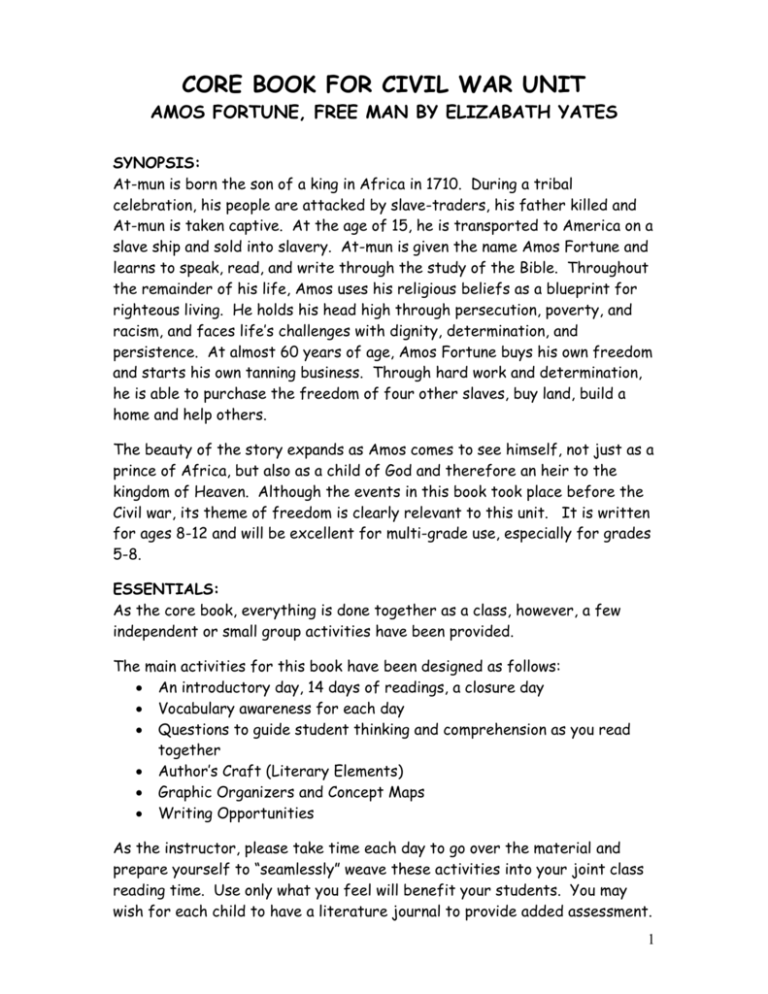
CORE BOOK FOR CIVIL WAR UNIT AMOS FORTUNE, FREE MAN BY ELIZABATH YATES SYNOPSIS: At-mun is born the son of a king in Africa in 1710. During a tribal celebration, his people are attacked by slave-traders, his father killed and At-mun is taken captive. At the age of 15, he is transported to America on a slave ship and sold into slavery. At-mun is given the name Amos Fortune and learns to speak, read, and write through the study of the Bible. Throughout the remainder of his life, Amos uses his religious beliefs as a blueprint for righteous living. He holds his head high through persecution, poverty, and racism, and faces life’s challenges with dignity, determination, and persistence. At almost 60 years of age, Amos Fortune buys his own freedom and starts his own tanning business. Through hard work and determination, he is able to purchase the freedom of four other slaves, buy land, build a home and help others. The beauty of the story expands as Amos comes to see himself, not just as a prince of Africa, but also as a child of God and therefore an heir to the kingdom of Heaven. Although the events in this book took place before the Civil war, its theme of freedom is clearly relevant to this unit. It is written for ages 8-12 and will be excellent for multi-grade use, especially for grades 5-8. ESSENTIALS: As the core book, everything is done together as a class, however, a few independent or small group activities have been provided. The main activities for this book have been designed as follows: An introductory day, 14 days of readings, a closure day Vocabulary awareness for each day Questions to guide student thinking and comprehension as you read together Author’s Craft (Literary Elements) Graphic Organizers and Concept Maps Writing Opportunities As the instructor, please take time each day to go over the material and prepare yourself to “seamlessly” weave these activities into your joint class reading time. Use only what you feel will benefit your students. You may wish for each child to have a literature journal to provide added assessment. 1 VOCABULARY: (Numbers in parentheses represent page numbers) Possible Ideas: Give each student mini sticky-notes to highlight words that they do not understand, or want more information on. Students could create ongoing class vocabulary visual by assigning different words to individual students. When a student is assigned a work they can create small quad-frames (a square with an x dividing it into four sections) for each word. One section for the word; one section for the sentence containing the word; one section for the meaning; and one section for a picture illustrating the meaning. Mount the frames as desired to create mobiles, quilt, bulletin board, etc. Present students with multiple definitions and have children choose correct meanings as they read words in context. Vocabulary sheets have been provided that state the definitions only. They can be used in a variety of ways, such as: 1. Make an overhead and write in words as you come to them in the reading. 2. Give each student their own sheet and they fill in the words as come across them in reading. 3. Use as a quiz. Create a matching game, etc. DURING THE READING: As you and your students read together, think out loud, ask questions, comment on pictures that come to your mind. Help students see your thinking as much as possible. The Questions given are designed to help you guide the students’ comprehension and provide you with a springboard to stimulate discussions. Never feel obligated to use everything. Use what you need to provide your students with what they need. AUTHOR’S CRAFT: When the entire class is working together, it is an ideal time to present Literary Elements, the main tools in author’s craft. Students will grasp the basics at their own level. When Graphic Organizers are used they are designed to do on overhead or computer presentation so entire class can participate. Teaching the literary elements to the entire class will make it easier to model what you want students to do in their individual reading classes. WRITING OPPORTUNITIES: Use at your discretion, to provide ideas, individualization, and/or ownership of text. 2 BACKGROUND INFORMATION TRIANGULAR TRADE ROUTE The most massive of all slave trading systems was the Atlantic slave trade. The route of the slave trade ran a triangular course. Ships left Europe with goods such as molasses and rum, which were traded for slaves in Africa. From there the slaves were taken to the New World, where they were sold for cash or exchanged for goods. The final leg involved the sale of these goods in Europe. SLAVERY IN THE NORTH Before the American Revolution, slavery extended from the shops of New England to the plantations of Georgia. In the decades afterward, as slavery became more fixed in the South, it began to disappear in the North. Slavery was gradually abolished in the North, beginning with Vermont in 1777 and concluding with New York in 1817. Although the northerners deserve some credit for acting morally, the main reason for the abolishment of slavery in the North was purely economical. The Northern states were substantially populated and whites feared losing jobs to black slaves. In addition, slaves in the North were not as important to the Northern economy as they were to the economy of the South, where they worked the large plantations. Northern businessmen might not have owned slaves themselves, but they did not give up their profitable trade based on southern slavery. New England industry grew rich and powerful from the African slave trade and business with southern slaveowners. Although they freed their slaves, white northerners were not without prejudice. Free blacks could not vote, or serve on a jury. They could not serve in the army with white soldiers, or hold any political office. They were made to sit in separate areas in churches, and most attended separate schools. The thought of blacks receiving a decent education in their neighborhoods led to violence in several New England communities. THE QUAKERS The Religious Society of Friends is a Protestant sect dating back to 17th century England. Its members, known as Quakers, believe that God dwells internally in the heart of every human being and provides direct inspiration for the living of a perfect life. This direct relationship, called the Inner Light, is reflected in a strict mode of living, an emphasis on spiritual responsibility, and a strong feeling of concern for fellow human beings. Whipped, jailed, and even executed in England, the Quakers began coming to America in 1656. One of the trademarks of the Quakers is their insistence upon equality regardless of race, creed, and national origin. As strange as it seems, some Quakers did own slaves, however, they were among the first to release them. Quakers were active in the anti-slavery movement, the Underground Railroad, and in promoting the welfare of freed slaves. 3 AMOS FORTUNE, FREE MAN by ELIZABATH YATES DAY 1 – INTRODUCTION TO BOOK CONNECT: Limit the freedom your students have in some way that they will notice. Perhaps the area they can play in at recess, who they eat with, when they can do something. You may even want to start taking some things that belong to them, a piece of fruit at lunch, a pencil, …” Do this until they grumble and start with “That’s not fair.” ATTEND: Talk about how they feel to loose freedoms they are use to and things that belong to them. Begin with the story of Joseph. Remind the students that he was a favored son of Jacob. He was treated like a prince, given the best of everything, until that awful day when his brothers sold him into slavery. IMAGINE “Imagine how you would feel if you were suddenly captured and forced to leave your homeland. After three months of harsh captivity, you arrive in a new country and are sold into slavery. You don’t know the language, and you struggle to hold on to your past life. What do you think it would be like? ” After students have had some time to think about how Joseph felt, you may wish the students to discuss what the following words mean and how they relate to the Joseph story: self-worth, determination, dreams, perseverance, and courage. INFORM, PRACTICE The last activity for today is to hand out copies of the book to the students. Ask them NOT to open the book, ONLY look at outside for now. Have students study the cover, consider the title, and read together the synopsis on the back. Invite students to discuss what you have read and complete together the Book Clue Search chart (page 5). You may wish to post predictions on chart paper. INFORM, PRACTICE, EXTEND As you read Amos Fortune together over the next four weeks, students will see many similarities to the Joseph story and their own lives. They will also learn more about slavery in America, the need for personal excellence and self-discipline, and the powerful impact the Bible and the indwelling of the Holy Spirit have on the success of an individual’s life. REFINE, PERFORM After the book is completed, a day will be given to bringing closure to this text. Activities will help refine what has been studied and celebrate the Freedom we have through Christ Jesus our Lord. 4 AMOS FORTUNE, FREE MAN by ELIZABATH YATES DAY 1 BOOK CLUE SEARCH INFORMATION SOURCE INFORMATION PROVIDED Title Cover Teasers on the Cover Reviewers’ Recommendations/ Awards Won Teacher’s Introduction Predictions about the book: 5 AMOS FORTUNE, FREE MAN by ELIZABATH YATES DAY 2 – Africa 1725, pages 3-13 Vocabulary: equatorial (3), mystic (3), conical (4), fervor (4), obeisance (4), pagan (5), reverberations (6), seethed (9), shackles (10), audible (11) Questions: (7) According to the incantation, what do the At-mun-shi people worship? (nature) (8) What does the old woman mean when she taps her head saying, “Not with this will he rule, but so,” laying her hand on her heart? (She is saying that At-mun has a good, kind heart, and he will rule his people well.) (3-8) Why were the At-mun-shi undefended and all congregated in one place? (They were celebrating a festival, time to plant the corn.) (9-12) Why were the At-mun-shi attacked? (Slave Traders collecting slaves.) (9-13) In what way did At-mun act differently from the rest of the captives? What accounted for the difference? (Unlike the other captives, At-mun was bold and held his head high. He acted this way because he recognized his role as leader of his people.) (13) At the end of the first chapter, At-mun reminds his sister that she is a princess. Why do you think these are his parting words? (Answers will vary) Author’s Craft: Setting Setting refers to the place and time in which the events in a work of fiction occur. The setting changes several times throughout this novel. Discuss each setting as it occurs in the book. Help students to “picture” the setting in their mind. Provide students with the opportunity to draw pictures of the setting changes as they occur in the book. Create a setting mural along one wall Writing: Informative Writing There appears to be no written record of the At-mun-shi tribe in Africa except in the book Amos Fortune: Free Man. Based on the information provided in the first two chapters of the book, write an essay explaining why you think the tribe cannot be found. 6 AMOS FORTUNE, FREE MAN by ELIZABATH YATES DAY 2 – Vocabulary for pages 3-13 (TE) To be full of bustling activity - seethed shaped like a cone -conical iron cuffs and chains - shackles mysterious, hard to explain - mystic echoing sounds - reverberations intensity -fervor located near the equator - equatorial one who worships false gods - pagan able to be heard - audible respectful gesture - obeisance equatorial (3), mystic (3), conical (4), fervor (4), obeisance (4), pagan (5), reverberations (6), seethed (9), shackles (10), audible (11) 7 AMOS FORTUNE, FREE MAN DAY 2 – Vocabulary for pages 3-13 As we read the story, look for the word that match the following definitions. Please find a word that means: To be full of bustling activity_____________________ shaped like a cone _____________________________ iron cuffs and chains ___________________________ mysterious, hard to explain ______________________ echoing sounds ________________________________ intensity _____________________________________ located near the equator ________________________ one who worships false gods ______________________ able to be heard _______________________________ respectful gesture ______________________________ equatorial (3), mystic (3), conical (4), fervor (4), obeisance (4), pagan (5), reverberations (6), seethed (9), shackles (10), audible (11) 8 AMOS FORTUNE, FREE MAN by ELIZABATH YATES DAY 3 – The Middle Passage, pages 14-27 Vocabulary: abashed (15), brandished (20), shrewd (24), docile (24) Questions: (18) What do you think At-mun is feeling as he leaves the familiarity of the jungle and journeys farther from his home than he had ever been before? (Responsibility for protecting and leading his people, anticipation, wonder, curiosity, fear of the unknown) (20) What does the author mean by the following, “To them it was a great bird sent for their deliverance and in his heart each one hailed it”? (The Atmun-shi have been treated so badly up to this point that they hope to be delivered from their present situation into a better arrangement.) (22-23) How were the tribesmen and women like merchandise after three weeks in the pit? (Because of the deprivation in the pits, the Africans become dispirited and obedient. They lost their tribal allegiances and interest in former personal relationships. With pride gone, they only thought about survival in its most basic form. They are treated as things to sell rather than as people who have emotional and physical needs and deserve respect.) (25) What does the author mean when she writes, “But the waves slapping against the ship had more meaning than the words shouted through the hatch? (The captives don’t understand what the traders are shouting, but they know they are leaving their families and homeland.) (27) Why do you think it is so important to At-mun to remember he is a king? (Answers may vary, He understands his self-worth regardless of the external circumstances. This theme is repeated throughout the book) Author’s Craft: Character Development Authors develop the characters in their stories in many ways. Use the chart provided, or one of your own to help your students see how Yates leads the reader to better understand the character of Amos. Keep the chart and add information to it during the duration of the book. Character Map other characters in the book as you come in contact with them. Writing: Journal Image that you are Ath-mun. In a journal entry, write about the attack of the slavers. Describe your feelings about the death of your father and the capture of your brother. Also, tell what you plan to do now that they are both gone. 9 CHARACTER ANALYSIS SHEET Character’s Voice What the character says: Character’s Voice What the words show: Character’s Deeds What the character does: Character’s Deeds What the actions show: Character’s Thoughts and Feelings What the character thinks and feels: Character’s Thoughts and Feelings What the thoughts and feelings show: Character’s Looks Hair Color Eye Color Age Height Distinguishing features: What Others Say about the Character Character’s Looks Similarities to me: Differences: What We Learn About the Character From Them 10 AMOS FORTUNE, FREE MAN by ELIZABATH YATES DAY 3 – Vocabulary for pages 14-27 (TE) to make someone feel ashamed - abased clever and probably accurate -shrewd quiet and easy to control - docile wave something about - brandished abashed (15), brandished (20), shrewd (24), docile (24) 11 AMOS FORTUNE, FREE MAN DAY 3 – Vocabulary for pages 14-27 As we read the story, look for the word that match the following definitions. Please find a word that means: to make someone feel ashamed ________________________ clever and probably accurate __________________________ quiet and easy to control _____________________________ wave something about _______________________________ abashed (15), brandished (20), shrewd (24), docile (24) 12 AMOS FORTUNE, FREE MAN by ELIZABATH YATES DAY 4 –The Middle Passage, Boston 1725-1740, pages 27-40 Vocabulary: wharf (28), raucous (30), truculent (32), stalwart (34), beckoning (38), relinquished (40) Questions: (27) On the ship, why did At-mun compel himself to remember the past? (By remembering the past, At-mun believed he could hold on to the heritage which the white men were trying to take from him.) (32) Why did At-mun answer the Quaker when he had answered no white man before? (At-mun answered the Quaker because his tone of voice indicated that he was not issuing a command, a curse, or a threat like all the other white men.) (33) When you consider his religious beliefs (see Background Information – The Quakers, page 3), why do you think Caleb Copeland purchased a slave? (Answers will vary) (34-36) How did Caleb justify the purchase of a slave to his wife? (Caleb justified his purchase of a slave by telling his wife that he bought him outright, knew they needed additional help at home, and saw the opportunity to help someone.) (39-40) How does Celia know “At-mun“ is not a sound, but a word in Amos’ native language? (Answers will vary) (40) What problems did Amos face adjusting to his new life with the Copelands? How did Celia Copeland make things easier for him? (Amos could not speak English and did not understand customs such as sleeping on a bed or eating with a knife and fork. Celia made things easier for him by being kind and patient, teaching him as she would a child) Author’s Craft: Setting and Character (continued) The setting of the story has switched locations many times thus far. You may wish to allow students to draw pictures of the settings depicted as they occur in the story to continue your setting mural (Village, canoe trip down river, White Falcon, slave market, Copeland Farm) Continue to add information gained about Amos, and other characters to the Character chart or map that class is creating. 13 AMOS FORTUNE, FREE MAN by ELIZABATH YATES DAY 4 – Vocabulary for pages 27-40 (TE) gesture to somebody to come - beckoning unpleasantly loud -raucous strongly built - stalwart loading place for ships - wharf renounced or surrendered something - relinquished aggressively defiant -truculent wharf (28), raucous (30), truculent (32), stalwart (34), beckoning (38), relinquished (40) 14 AMOS FORTUNE, FREE MAN DAY 4 – Vocabulary for pages 27-40 As we read the story, look for the word that match the following definitions. Please find a word that means: gesture to somebody to come _________________________ unpleasantly loud __________________________________ strongly built ______________________________________ loading place for ships _______________________________ renounced or surrendered something ____________________ aggressively defiant _________________________________ wharf (28), raucous (30), truculent (32), stalwart (34), beckoning (38), relinquished (40) 15 AMOS FORTUNE, FREE MAN by ELIZABATH YATES DAY 5 – Boston 1725-1740, pages 40-52 (TE) Vocabulary: cipher (40), servitude (43), admonition (45), renowned (47), vendue (49), immemorial (50), Questions: (40-41) Why do you think the Bible is used for all schooling in the Copeland household? (It likely is one of the few books in the house. Quakers are very stern in their religious faith and believe that all lessons in life come from the Bible.) (41-42) How does Amos realize the word “king” refers to a person of worth? (Answers will vary. As Roxanna reads from the Bible, Amos understands that every person is of value in God’s eyes, regardless if color or station in life.) (46) Why doesn’t Amos want to gain his freedom too soon? (Amos has seen the difficulties experienced by former slaves who are not prepared to earn a living in a society where even free blacks lack status because of the color of their skin.) (48) Why is Amos interested in the slave ships that come to Boston? (Amos hopes to someday find Ath-mun.) (49) How does Amos feel when he learns he will be sold? (He is confident everything will turn out okay.) (50) For what is Amos saving money? (To purchase his sister’s freedom if she ever comes to America.) (50) What does the author mean when she writes, “The sun stood still over Africa, it was only in America that it moved” (In Amos’ mind, his family, village, and homeland are set unchanging in one moment of time. Even though he has been in America for 15 years, he still looks for a 12-year-old girl with a limp.) Author’s Craft: Simile A simile is a figure of speech in which a comparison between two unlike objects is stated directly using the words “like” or “as”. For example: (10) But the slavers, advancing among them, tossed the At-mun-shi about like leaves in a wind. (38) [Amos follows] “like an obedient dog” (48) “a smile like the first rays of dawn” Look for examples of simile throughout the text: Ask students What is being compared in this simile? What does the author want to reveal to us through this simile? 16 AMOS FORTUNE, FREE MAN by ELIZABATH YATES DAY 5 – Vocabulary for pages 40-52 (TE) advise - admonition public sale -vendue the state of being a slave - servitude famous -renowned to understand a written code (in this case math) - cipher ancient - immemorial cipher (40), servitude (43), admonition (45), renowned (47), vendue (49), immemorial (50), 17 AMOS FORTUNE, FREE MAN DAY 5 – Vocabulary for pages 40-52 As we read the story, look for the word that match the following definitions. Please find a word that means: advise _________________________________________ public sale ______________________________________ the state of being a slave __________________________ famous _________________________________________ to understand a written code (in this case math) ________ _________________________ ancient _________________________________________ cipher (40), servitude (43), admonition (45), renowned (47), vendue (49), immemorial (50), 18 AMOS FORTUNE, FREE MAN by ELIZABATH YATES DAY 6 – Woburn 1740-1779, pages 53-67 Vocabulary: tallow (55), Sabbath (56), vigilant (56), vex (56), fraught (57), stolid (59), remonstrated (64), covenant (65), Questions: (56) What does the author mean when she writes, “It was not with his own people he felt at his best but with all men” (Amos is the same person whether at church or in the tanning yard. He treats every person, regardless of skin color, with care and respect.) (__) Is religion important to Amos? (Throughout the book, Amos shows that religion is very important to him He lives every day according to his religious beliefs.) (__) Name some basic freedoms that are not granted to slaves. (Answers may vary, could include, the freedom to come and go as they please, choice of a spouse, choose of work, being paid a decent wage) (62) Why does Amos cry when he looks in the polished tin? (Time has passed, and Ath-mun is no longer the young girl he has been looking for at the wharf.) (64) What is Mrs. Richardson’s opinion about slavery? (It is wrong to force people to leave their native land and treat them as persons of lesser worth.) (65) After the conversation with Mrs. Richardson, what does Mr. Richardson change about his agreement with Amos? (He requires that Amos only work four years instead of the six years he and Amos had agreed upon.) Author’s Craft: Comparing Characters Amos had two masters – Caleb Copeland and Ichabod Richardson. Use a Venn diagram to compare the two. Writing: Comparisons Written and spoken English in the 1700s was much different than today’s English. Rewrite the letter granting Amos his freedom (64-65) in today’s English. Writing: Letter After Amos was purchased by Ichabod Richardson, he promised to write to Celia Copeland. Imagine that you are Amos, and write a letter to Mrs. Copeland revealing your thoughts and feelings about your new life with the Richardsons. 19 VENN DIAGRAM Caleb Copeland Ichabod Richardson Same 20 AMOS FORTUNE, FREE MAN by ELIZABATH YATES DAY 6 – Vocabulary for pages 53-67 (TE) to agitate or annoy - vex protested -remonstrated a day set aside for the worship of God - Sabbath to be tense or anxious -fraught a pledge - covenant watchful - vigilant impassive, showing no emotion - stolid fatty substance used to make candles - tallow tallow (55), Sabbath (56), vigilant (56), vex (56), fraught (57), stolid (59), remonstrated (64), covenant (65), 21 AMOS FORTUNE, FREE MAN DAY 6 – Vocabulary for pages 53-67 As we read the story, look for the word that match the following definitions. Please find a word that means: to agitate or annoy _________________________________ protested _________________________________________ a day set aside for the worship of God _________________ to be tense or anxious ______________________________ a pledge _________________________________________ watchful _________________________________________ impassive, showing no emotion _________________________ fatty substance used to make candles __________________ tallow (55), Sabbath (56), vigilant (56), vex (56), fraught (57), stolid (59), remonstrated (64), covenant (65), 22 AMOS FORTUNE, FREE MAN by ELIZABATH YATES DAY 7 – Woburn 1740-1779, pages 67-80 Vocabulary: abated (69), stipulated (70), oppression (72), severance (72), tolerant (76), ascribed (77), Questions: (71) Why does Amos say “blacks are used to waiting”? (Answers may vary. They are waiting to be set free.) (73) Why is Mr. Twombly surprised to see Amos? (Amos has the money to buy Lily’s freedom even though she is sickly.) (74) Why is it important to Amos to free Lily and Lydia? (In freeing them, he hopes to provide freedom to Ath-mum, if she is in need of freedom.) (79) Why does Amos not argue with Mr. Bowers’ price for Lydia? (Amos does not want to barter over a human being. He also knows a a black man, he has no leverage to question a white man.) (__) Do you think Amos’ sister will arrive on a boat from Africa, why or why not? (Answers will vary) Author’s Craft: Allusion In literature, an allusion is a reference to something outside the work, usually to another piece of literature or to a well-known person, place or event from history, religion, or mythology. For example, in this chapter, Amos though about Moses standing upon Mount Nebo. Guide students in thinking about ways Amos’s life was like that of Moses. (Amos is almost 60 years old when he finally experiences freedom. Moses lived to be 120 years old and was still mentally and physically strong. Amos feels that he is like Moses in that he has something to live for, is still strong, and will live a long time.) Writing: News Article Imagine you write news articles for a Quaker newsletter in the year that Amos received his freedom. Write an article telling about Amos and his hopes for the future. (Do not use the typical Quaker “thee” and “thou”.) 23 AMOS FORTUNE, FREE MAN by ELIZABATH YATES DAY 7 – Vocabulary for pages 67-80 (TE) to agitate or annoy - vex protested -remonstrated a day set aside for the worship of God - Sabbath to be tense or anxious -fraught a pledge - covenant watchful - vigilant impassive, showing no emotion - stolid fatty substance used to make candles - tallow abated (69), stipulated (70), oppression (72), severance (72), tolerant (76), ascribed (77), 24 AMOS FORTUNE, FREE MAN DAY 7 – Vocabulary for pages 67-80 As we read the story, look for the word that match the following definitions. Please find a word that means: to agitate or annoy _________________________________ protested _________________________________________ a day set aside for the worship of God _________________ to be tense or anxious ______________________________ a pledge _________________________________________ watchful _________________________________________ impassive, showing no emotion _________________________ fatty substance used to make candles __________________ abated (69), stipulated (70), oppression (72), severance (72), tolerant (76), ascribed (77), 25 AMOS FORTUNE, FREE MAN by ELIZABATH YATES DAY 8 – Journey to Keene 1779, pages 81-92 Vocabulary: bondage (83), robust (85), consigned (86), ensue (86) Questions: (82) What does the author mean when she writes of Amos, “A strange thing freedom was, he thought, with its side of shadow as well as light”? (Amos is free of household cares and domestic ties, but he longs for a woman to share his life with.) (82-83) Why is Amos especially excited about Celyndia’s freedom? (He wants her to grow up free , so she will never feel that slavery’s social barriers apply to her.) (84) Why does Amos like the little town he comes to on his way to Keene? There is a great Meeting House and a tall mountain, both pointing heavenward.) (85) What can you tell about Amos from the way he treats Cyclops? (He is a caring gentle person.) (86) What important truth does Amos understand about the inequality between white men and free black men? (Even when he is free, a black man does not have the same rights as a white man and therefore must be agreeable so he doesn’t draw undue attention to himself.) (87-89) Does Samuel George recognize that Amos is doing him a favor? (No, Samuel thinks of Amos as being childlike rather than recognizing that Amos took the clothes as much to help Samuel as himself.) (92) Why does Celyndia cry when Amos reminds her she is free? (Answers will vary, Sometimes happiness brings tears.) Author’s Craft: Metaphor A metaphor is a figure of speech in which a comparison of unlike objects is suggested or implied. For example: (20) “ [the ship] was a great bird” (40)… words that burned themselves into his mind and burned away the shackles hate had put to his lips … Ask students to find what is being compared and explain why these are apt metaphors? Update character charts and/or setting mural if necessary. 26 AMOS FORTUNE, FREE MAN by ELIZABATH YATES DAY 8 – Vocabulary for pages 81-92 (TE) slavery - bondage hardy or healthy -robust delivered - consigned result -ensue bondage (83), robust (85), consigned (86), ensue (86) 27 AMOS FORTUNE, FREE MAN DAY 8 – Vocabulary for pages 81-92 As we read the story, look for the word that match the following definitions. Please find a word that means: slavery - _______________________________________ hardy or healthy -________________________________ delivered - ______________________________________ result -________________________________________ bondage (83), robust (85), consigned (86), ensue (86) 28 AMOS FORTUNE, FREE MAN by ELIZABATH YATES DAY 9 – The Arrival at Jaffrey, pages 93-108 Vocabulary: diligently (94), frugally (94), dolefully (99), pilgrimage (100), shrewdly (102), endeavor (102), liability (103), impoverished (103), deferential (103), probation (104) Questions: (94-95) Amos sets out with an ax and a bag of beans as his prized possessions when he, Violet, and Celyndia leave for the trip to Jaffery. What would you take as your prized possession for survival and why? (Answers will vary) (96) Why do you think Violet’s favorite color is white? (Answers will vary. In her mind, white stands for freedom, richness, and everything good.) (98) What does being a king mean to Amos? (Answers will vary. Amos knows that he was born to be a king in Africa, but he believes that living a God-centered, righteous life makes him a king in his present circumstances.) (105) How does Amos use his talents to get what he needs? (He shows that he has a skill the town needs in order to get a loan of a parcel of land on which to start his tanning business.) (108) What emotions do you think Amos is feeling as he, Violet and Celyndia spend their first night in Jaffrey? (Answers will vary. Elation, anticipation, peace, contentment) (__) How do you think Violet will match Amos’ kindness for purchasing her freedom? (Answers will vary) Author’s Craft: Story Map A Story Map can help the reader get a “picture” of how the author is developing the story line (plot) of the book. Have students choose a problem that Amos Fortune encountered thus far in the story and complete the Story Map on page 29. Writing: Journal Amos sets out with an ax and a bag of beans as his prized possessions when he, Violet, and Celyndia leave for the trip to Jaffrey. What would you takeas your prized possessions for survival and why? 29 STORY MAP Setting: Characters: Problem: Event 1: Event 2: Event 3: Event 4: Solution or Conclusion: 30 AMOS FORTUNE, FREE MAN by ELIZABATH YATES DAY 9 – vocabulary for pages 93-108 (TE) a journey to a special place -pilgrimage cleverly accurate - shrewdly obligation under the law - liability period of testing somebody’s suitability – probation persistently, hardworking effort - diligently showing respect – deferential thriftily, avoiding waste -frugally try to do something - endeavor very sad and mournfully - dolefully diligently (94), frugally (94), dolefully (99), pilgrimage (100), shrewdly (102), endeavor (102), liability (103), impoverished (103), deferential (103), probation (104) 31 AMOS FORTUNE, FREE MAN DAY 9 – vocabulary for pages 93-108 As we read the story, look for the word that match the following definitions. Please find a word that means: a journey to a special place -__________________________ cleverly accurate - _________________________________ obligation under the law - ____________________________ period of testing somebody’s suitability – ________________ persistently, hardworking effort -______________________ showing respect – __________________________________ thriftily, avoiding waste -____________________________ try to do something - _______________________________ very sad and mournfully - ____________________________ diligently (94), frugally (94), dolefully (99), pilgrimage (100), shrewdly (102), endeavor (102), liability (103), impoverished (103), deferential (103), probation (104) 32 AMOS FORTUNE, FREE MAN by ELIZABATH YATES DAY 10 – Hard Work fills the Iron Kettle 1781-1789, pages 109-121 Vocabulary: prostrate (109), abode (110), pliable (112), convex (117), concave (117), impervious (118), pliant (118), demurely (120) Questions: (110-111) Why does Celyndia still question whether she can go and do as she pleases? (She has been a slave since birth and has never known freedom.) (115) Amos leads a truly happy life. Where does this happiness come from? What do you think he sees as his life’s purpose? (Answers will vary) (115-116) Violet sees Amos as climbing a mountain in his mind. What does she mean by this? (Answers will vary) (120) Why is there a separate place for blacks to worship in the church? (The white population does not view the black population as equal, no matter how well educated, successful in business, or helpful to the community.) Author’s Craft: Story Map (cont.) Choose a different problem from the story to “map” out. Writing: How-to Paragraph Read the steps for tanning leather in the 1700s (117-119). Write a “How-to Tan Leather” paragraph. End your paragraph by stating possible uses for your product. 33 AMOS FORTUNE, FREE MAN by ELIZABATH YATES DAY 10 – Vocabulary for pages 109-121 (TE) curved inwardly - concave flexible - pliable lie face downward -prostrate looking shyly modest - demurely not letting something through – impervious outwardly curving – convex somebody’s home - abode supple and bending easily -pliant prostrate (109), abode (110), pliable (112), convex (117), concave (117), impervious (118), pliant (118), demurely (120) 34 AMOS FORTUNE, FREE MAN DAY 10 – Vocabulary for pages 109-121 As we read the story, look for the word that match the following definitions. Please find a word that means: curved inwardly - __________________________________ flexible - ________________________________________ lie face downward -________________________________ looking shyly modest - ______________________________ not letting something through – _______________________ outwardly curving – ________________________________ somebody’s home - ________________________________ supple and bending easily -__________________________ prostrate (109), abode (110), pliable (112), convex (117), concave (117), impervious (118), pliant (118), demurely (120) 35 AMOS FORTUNE, FREE MAN by ELIZABATH YATES DAY 11 – Hard Work Fill the Iron Kettle 1781-1789, Amos on the Mountain, pages 121-137 Vocabulary: chippered (124), bevy (125), feign (129), excavate (130), intimidation (136) Questions: (122) Why do you think it took so long for Amos to be invited to join the church he attended in Jaffrey? (Answers will vary. ) (127) What kind of person is Lois Burdoo? (She is dependent on the charity of others for her survival. She does not seem to be able or willing to provide for herself and her family.) (132) Do you think Violet is right in not wanting to help the Burdoo family? (Answers will vary.) (134) Why does Violet keep her eyes on the mountain as she tells Amos about hiding the kettle? (Answers will vary. She looks to the mountain for the strength to stand up for something in which she believes.) (135) What, besides the mountain, gives Violet the strength to stand up to Amos? (She knows Amos repeatedly sets his own dreams aside for the sake of others. She speaks for the part of Amos that needs to see his dreams fulfilled.) (134-136) Who makes the better argument for what should be done with the money? (Answers will vary) (136) Violet says, “You’ll do more for them all by giving work to the boys than by giving money to Lois”. What does she mean by that? (It is better to teach the boys a skill they can use to support themselves and their family than to give them money.) Author’s Craft: Plot Plot is the author’s way of presenting the important events of a story. Visualizing the plot of a story helps the students develop knowledge of text structure, improve comprehension, help with retelling the story in summary fashion, and enhances students’ knowledge of the art of composing a good story. Plot usually consists of an initial conflict, rising action, climax, falling action, and resolution. Using the form on page 37 or your own more realistically drawn mountain, help students plot the story thus far. 36 PLOT DIAGRAM MOUNTAIN Climax Rising Action Initiating Conflict Falling Action Resolution 37 AMOS FORTUNE, FREE MAN by ELIZABATH YATES DAY 11 – Vocabulary for pages 121-137 (TE) group of animals - bevy pretend something - feign to remove earth -excavate cheerful - chippered to create a feeling of fear - intimidation chippered (124), bevy (125), feign (129), excavate (130), intimidation (136), 38 AMOS FORTUNE, FREE MAN DAY 11 – Vocabulary for pages 121-137 As we read the story, look for the word that match the following definitions. Please find a word that means: group of animals - _________________________________ pretend something - ________________________________ to remove earth -__________________________________ cheerful - ________________________________________ to create a feeling of fear -__________________________ chippered (124), bevy (125), feign (129), excavate (130), intimidation (136) 39 AMOS FORTUNE, FREE MAN by ELIZABATH YATES DAY 12 – Amos on the Mountain (137-145) Vocabulary: stifled (138), composure (139), summit (140), Questions: (138) What do Amos and Violet do to resolve the disagreement about how to spend their savings? (They both ask for God’s guidance in prayer.) (139) What does this statement mean, “Yet he owned no land, nothing they could call theirs if the chariot came for him soon”? (Answers will vary. Amos doesn’t own land and couldn’t leave any provisions for his family if he died right away.) (138-141) Why does Amos go to the mountain to pray about the money situation? (He sees the mountain as being closer to God. He is troubled and needs answers.) Author’s Craft: Plot (cont.) Continue the discussion on Plot if necessary. Writing: Interview Write an interview dialog between the elders of the church that Amos attended in Jeffrey and Amos, himself, as they discuss the possibilities of allowing him church membership. Writing: Journal Violet is unsure that she has done the right thing by hiding Amos’s kettle. Tell about a time when you agonized over a decision that you made. Think about a time when you chose to do something you believed in even though you weren’t sure if you were right or wrong. What was the action you took? Why were you unsure that you had done the right thing? How did the event turn out? 40 AMOS FORTUNE, FREE MAN by ELIZABATH YATES DAY 12 – Vocabulary for pages 136-145 highest point of mountain – summit suffocate – stifled emotional control – composure stifled (138), composure (139), summit (140), 41 AMOS FORTUNE, FREE MAN DAY 12 – Vocabulary for pages 136-145 As we read the story, look for the word that match the following definitions. Please find a word that means: highest point of mountain – _________________________ suffocate -______________________________________ emotional control - _______________________________ stifled (138), composure (139), summit (140), 42 AMOS FORTUNE, FREE MAN by ELIZABATH YATES DAY 13 – Auctioned for Freedom, pages 146-158 Vocabulary: indentured (147), abeyance (149), illiteracy (149), bolster (150), expedient (150), indigent (150), dispatched (153), reverie (157), leniency (158) Questions: (148) Why do you think Amos feels he owes Violet? (Answers will vary) (150) Do you think the Public Vendue was a good plan for towns to care for the needy in the late 1700’s? (Answers will vary.) (153) How does a mountain give someone strength? (Answers will vary.) (156) Amos says, “Wings can’t grow without a little suffering.” What does he mean by this? (Answers will vary. Going through difficult times often makes a person stronger and wiser.) (158) Why do you think Polly stares off all the time? (Answers will vary.) Author’s Craft: Symbolism A symbol is something that stands for something else. An author creates and uses a symbol to involve us personally in his work. Because each of us are different, the symbol can mean something to each person who reads the story. Elizabeth Yates uses the mountain as a symbol in this book. What does the mountain represent? ( strength, God, courage, determination, obstacles to overcome, the path to heaven, etc.) Writing: Compare and Contrast In Amos’ day, townspeople worked together to take care of those in need. Today we have many types of aid in the form of shelters, low rent housing, welfare, etc. Create a survey that allows people to compare the Public Vendue system (1700s) and the types of aid we aid today. Write an essay explaining which system most people thought was the most effective and why. 43 AMOS FORTUNE, FREE MAN by ELIZABATH YATES DAY 13 – Vocabulary for pages 146-158 (TE) daydream - reverie gentleness or tolerance - leniency poor – indigent promised work for a given time -indentured sent out -dispatched something achieving aims quickly - expedient suspension, temporary inactivity - abeyance to boost– bolster unable to read - illiteracy indentured (147), abeyance (149), illiteracy (149), bolster (150), expedient (150), indigent (150), dispatched (153), reverie (157), leniency (158) 44 AMOS FORTUNE, FREE MAN DAY 13 – Vocabulary for pages 146-158 As we read the story, look for the word that match the following definitions. Please find a word that means: daydream - ______________________________________ gentleness or tolerance - ___________________________ poor – __________________________________________ promised work for a given time -_____________________ sent out -_______________________________________ something achieving aims quickly - ____________________ suspension, temporary inactivity - ____________________ to boost– ________________________________________ unable to read - __________________________________ indentured (147), abeyance (149), illiteracy (149), bolster (150), expedient (150), indigent (150), dispatched (153), reverie (157), leniency (158) 45 AMOS FORTUNE, FREE MAN by ELIZABATH YATES DAY 14 – Auctioned for Freedom, Evergreen Years, pages 159-170 Vocabulary: fount (169), ebbing (169), Questions: (161) What does Violet see in Amos’ character that causes her to love him even more after Polly dies? (He is so unselfish and always thinks of others before himself.) (162) What does Amos mean when he says, “It does a man no good to be free until he knows how to live, how to walk in step with God”? (Answers will vary . Amos believes that true freedom comes by living a righteous, God-centered life and helping others.) (169-170) What does it mean that Amos will account to Ath-mun when they meet together at the Jordon? (Answers will vary. Amos devoted his life to helping helpless people in memory of his sister.) Author’s Craft: Comparing Characters The plot of a novel is the sequence of events that happen in the story. A conflict is a struggle between opposing forces. An external conflict is a character’s struggle against an outside force, such as nature, fate, or another person. An internal conflict is a personal struggle that takes place within a character’s mind. Use the chart on page 47 to list the conflicts that have occurred in the story so far. Indicate how come of these problems have been resolved. As you continue to read, add to the chart. 46 LITERARY ELEMENT: CONFLICT In the chart below, list the conflicts that have occurred in the story so far. Indicate how come of these problems have been resolved. As you continue to read, add to the chart. External Conflicts Resolutions Internal Conflicts Resolutions 47 AMOS FORTUNE, FREE MAN by ELIZABATH YATES DAY 14 – Vocabulary for pages 159-170 (TE) fading - ebbing a source - fount fount (169), ebbing (169), 48 AMOS FORTUNE, FREE MAN DAY 14 – Vocabulary for pages 159-170 As we read the story, look for the word that match the following definitions. Please find a word that means: fading - __________________________________________ a source - ________________________________________ fount (169), ebbing (169), 49 AMOS FORTUNE, FREE MAN by ELIZABATH YATES DAY 15 – Evergreen Years 1794 - 1801, pages 171-181 Vocabulary: affronts (171), pittance (172), notion (176), fidelity (181), solace (181) Questions: (172-173) How can hate be like a burning mountain? (Answers will vary. Fire can consume everything in its path. Hate can take over a person’s thoughts and actions and can destroy any joy in the person’s life. ) (179) What is different about the money Amos saves in the stone crock? Why do you think he saves the money separately from the money he earns tanning? (Answers will vary) (179-180) What do you think Amos hopes to accomplish by his donations to the church and school? (Answers will vary. He hopes for equality for the black and white populations.) Author’s Craft: Theme Theme is the central idea or the “message” of a story or novel. Don’t cofuse theme and plot: a theme is an underlying idea, not a series of events. There are three important points to remember when teaching theme: 1. a novel may have more than one theme 2. not everybody will agree on the theme of a novel, and 3. one person’s idea about a novel’s them is as good as anyone else’s – as long as it can be supported with evidence from the novel In pairs, have students come up with themes from Amos Fortune: Free Man. Write them on large strips of paper and decorate. On the back of the strip, students should write several sentences explaining how the theme relates to their lives. Writing: Eulogy A eulogy is a speech in praise of a deceased person. It usually tells about the person’s character traits and accomplishments. Write a fitting eulogy for Amos Fortune. 50 AMOS FORTUNE, FREE MAN by ELIZABATH YATES DAY 15 – Vocabulary for pages 171-181 (TE) an idea, opinion, or concept - notion insults - affronts loyality to - fidelity meager amount - pittance source of comfort - solace affronts (171), pittance (172), notion (176), fidelity (181), solace (181) 51 AMOS FORTUNE, FREE MAN DAY 15 – Vocabulary for pages 171-181 As we read the story, look for the word that match the following definitions. Please find a word that means: an idea, opinion, or concept -__________________________ insults - __________________________________________ loyality to - _______________________________________ meager amount - ___________________________________ source of comfort - ________________________________ affronts (171), pittance (172), notion (176), fidelity (181), solace (181) 52 AMOS FORTUNE, FREE MAN by ELIZABATH YATES DAY 16 – Closing Activities Possible Post – Reading Questions: How does Amos Fortune show courage and determination throughout his life? How do Amos’ religious beliefs affect the choices he makes throughout the book? Why is it important to Amos to be educated and free? What does Amos mean when he talks about his “promised land”? How is Amos’ character revealed as he purchases his own freedom and then the freedom of others? What do you think is the climax of the story? How do you think Amos’ experiences as a prince prepared him for his experiences as a freed slave? How does Amos’ attitude affect those who knew him? For what kind of person does Amos have a soft spot in his heart? Why? Why do you think Amos Fortune is a fitting name for the boy who was once a prince? Final Projects: Amos’s life has been deeply affected by the words that Roxanna once read to him from the Bible. Tell about a time when works had an important effect on you. What were the words? Why were they so important to you? In what ways did these words affect you life and your relationship with others? Make a collage that illustrates the concept of freedom. Illustrate why freedom is so important. Create a flow chart that shows the major events in the story in the order they occurred. Amos frequently looks to the mountain for strength. From what do you gain your strength? Write an essay, poem, or song telling about a supportive person, or comforting thing that gives you strength to do difficult things. Select one chapter from the book to dramatize or illustrate. Create a script, cast parts, and arrange for props. Present your play to the class. 53
